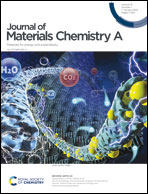Porphyrin framework-derived N-doped porous carbon-confined Ru for NH3BH3 methanolysis: the more pyridinic-N, the better†
Abstract
Encapsulating metal nanoparticles (MNPs) inside specific porous materials is considered as a feasible strategy to prepare ultrafine MNPs with high stability. Herein, ultrafine Ru nanoparticles (NPs) with a mean size of 3.2 nm encapsulated in an N-doped porous carbon (NC) derived from the pyrolysis of a new porphyrin framework (POF) were fabricated via a simple wet chemical method, in which the POF was synthesized using 4,4′-biphenyldicarboxaldehyde and pyrrole as raw materials. The tomographic characterization of reconstructed slices confirmed the successful encapsulation of Ru NPs in POF-NC600 (pyrolysis temperature T = 600 °C). Due to the confinement effects and anchoring effects of POF-NC600, Ru@POF-NC600 shows the smallest particle size of Ru NPs and the highest hydrogen production performance toward the methanolysis of ammonia borane (AB) among the investigated catalysts, providing a record initial turnover frequency (TOF) value of 727 min−1 at 25 °C as compared to those heterogeneous catalysts ever reported. Systematic investigations reveal that pyridinic-N plays a pivotal role in the particle size distribution of Ru NPs and catalytic activity of the catalyst. Extended studies confirm that pyridinic-N, as an efficient anchoring site, determines the dispersity and size distribution of Ru NPs, thus affecting the catalytic activity of the catalyst. The more pyridinic-N, the better the catalytic activity. A series of isotopic experiments were performed, and it is found for the first time that the cleavage of the O–H bond in methanol is involved in the rate-determining step (RDS) of AB methanolysis. This work offers insights into rationally designing stable and ultrafine metal NPs confined in pyridinic-N-rich composites for various applications.



 Please wait while we load your content...
Please wait while we load your content...